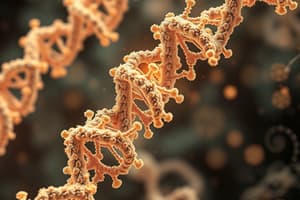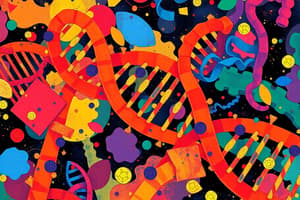Podcast
Questions and Answers
Match the following enzymes involved in DNA replication with their primary function:
Match the following enzymes involved in DNA replication with their primary function:
DNA polymerase = Adds nucleotides to the growing DNA strand Helicase = Unwinds the DNA double helix Primase = Synthesizes RNA primers to initiate DNA synthesis Ligase = Seals the gaps between Okazaki fragments on the lagging strand
Match the following terms with their relevant description regarding replication:
Match the following terms with their relevant description regarding replication:
Replication fork = The point where the DNA double helix unwinds Okazaki fragments = Short segments of DNA synthesized on the lagging strand Leading strand = Synthesized continuously in the 5' to 3' direction Lagging strand = Synthesized discontinuously in the 5' to 3' direction
Match the following DNA repair mechanisms with the type of damage they primarily address:
Match the following DNA repair mechanisms with the type of damage they primarily address:
Mismatch repair = Corrects errors in base pairing Nucleotide excision repair = Removes bulky DNA lesions Base excision repair = Removes damaged bases like uracil Double-strand break repair = Repairs breaks in both strands of DNA
Match the following features of DNA replication with their relevant description:
Match the following features of DNA replication with their relevant description:
Match the following terms with their correct definition:
Match the following terms with their correct definition:
Match the following stages of DNA replication with their corresponding events:
Match the following stages of DNA replication with their corresponding events:
Match the following factors with their influence on DNA replication:
Match the following factors with their influence on DNA replication:
Match the following concepts with their relevant explanation:
Match the following concepts with their relevant explanation:
Flashcards
Replication
Replication
The process of creating an identical copy of a DNA molecule.
DNA polymerase
DNA polymerase
An enzyme that adds nucleotides to the growing DNA strand.
Helicase
Helicase
An enzyme that unwinds the DNA double helix.
Leading strand
Leading strand
Signup and view all the flashcards
Lagging strand
Lagging strand
Signup and view all the flashcards
Semiconservative replication
Semiconservative replication
Signup and view all the flashcards
Mismatch repair
Mismatch repair
Signup and view all the flashcards
Nucleotide excision repair
Nucleotide excision repair
Signup and view all the flashcards
Study Notes
Defining Replication
- Replication, in the biological context, refers to the process of creating an identical copy of a DNA molecule.
- This is crucial for cell division and the transmission of genetic information.
- The process is highly accurate, minimizing errors in the copying of genetic material.
Key Players in Replication
- DNA polymerase: An enzyme responsible for adding nucleotides to the growing DNA strand.
- Helicase: Unwinds the DNA double helix to expose the template strands.
- Primase: Synthesizes RNA primers to initiate DNA synthesis.
- Ligase: Seals the gaps between Okazaki fragments on the lagging strand.
- Single-strand binding proteins (SSBs): Stabilize the single-stranded DNA.
Steps of Replication
- Initiation:
- The DNA double helix unwinds at specific points called origins of replication, creating replication forks.
- Helicase unwinds the DNA double helix.
- Single-strand binding proteins (SSBs) stabilize the separated strands.
- Elongation:
- DNA polymerase adds nucleotides complementary to the template strand.
- DNA polymerase can only synthesize in the 5' to 3' direction.
- Leading strand is synthesized continuously.
- Lagging strand is synthesized discontinuously in short fragments called Okazaki fragments.
- Primase synthesizes short RNA primers to initiate DNA synthesis on the lagging strand.
- Termination:
- Replication forks meet and replication is complete.
- DNA ligase seals the gaps between Okazaki fragments.
Semiconservative Replication
- The mechanism of DNA replication is semiconservative.
- Each new DNA molecule contains one original strand and one newly synthesized strand.
- This ensures the fidelity of genetic information.
Replication Errors and Repair Mechanism
- DNA replication is not perfect.
- Errors can occur during the process.
- DNA repair mechanisms are in place to correct errors and maintain accuracy.
- These mechanisms involve various enzymes and processes to identify and repair damaged or incorrectly replicated DNA. Different repair mechanisms target different types of DNA damage, such as:
- Mismatch repair: Corrects errors in base pairing.
- Nucleotide excision repair: Removes bulky DNA lesions.
- Base excision repair: Removes damaged bases like uracil.
Replication in Different Organisms
- The fundamental principles of replication are conserved across different organisms.
- However, specific enzymes and mechanisms might vary.
- Bacteria exhibit a different replication mechanism than eukaryotic organisms.
- Eukaryotic replication is more complex due to the larger size and linear nature of eukaryotic chromosomes.
Significance of Replication
- Essential for cell growth and reproduction.
- Ensures accurate transmission of genetic information from one generation to the next.
- Important for the functioning of all cellular processes.
- Mutations during replication can cause genetic diseases, and these are frequently addressed by medical intervention.
Studying That Suits You
Use AI to generate personalized quizzes and flashcards to suit your learning preferences.



